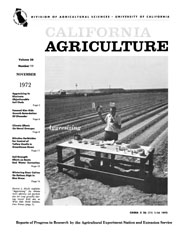


University of California
California Agriculture
|
|||
|
|||

Cover:
Burton J. Hoyle explains “Aggresizing” (to obtain more efficient soil particle size for crop growth) during recent field day at West Side Field Station, Five Points.
November 1972
Volume 26, Number 11 News and opinion |
|||
|
University of California, 1301 S. 46th St., Bldg. 478 Richmond, CA
|